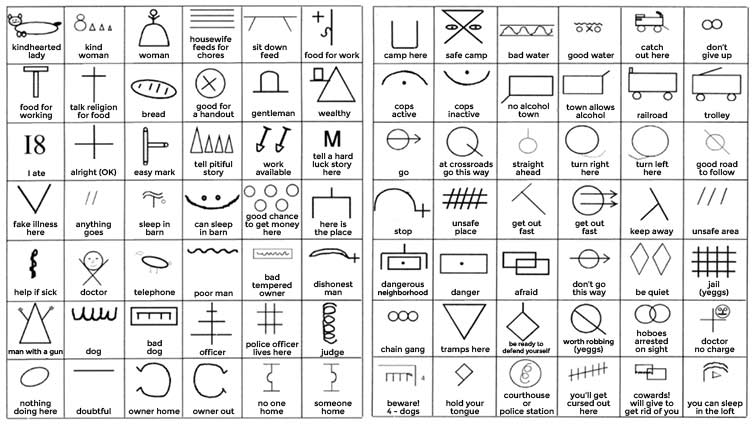One of the interesting things about customer opinion is you’ll never hear all of it. Even with the best customer feedback management in place, you’ll only hear from the customers who choose to provide feedback.
But rest assured, customers are forming opinions about your business in every interaction. And when they share those opinions, whether or not they share them with you, you’ll feel the impact.

First: A short digression on the secret languages of culture.
Let’s jump back quite a bit. 80 years or so.
In the Great Depression, thousands of men left their homes in search of work. Despite the singular nature of these migrant workers, they all faced similar circumstances. These “hobos” were in search of work, on the move, and privy to the dangers of life on the road. As such, they felt a sense of camaraderie in their lifestyle. And thus, a unique culture developed.
As hobos traveled through towns, they used a series of symbols to convey information to each other—including dangers, opportunities, and helpful tips.
Although many of the symbols have disappeared over time, here are a few that were catalogued (from the Hobo Museum in Britt, Iowa):

Such symbols allowed hobos to relay relevant information to each other, in a language only they could understand.
Second: What hobo cryptography has to do with customer experience strategy.
In a similar way, your individual customers are united in the circumstances that brought them to you. That’s what makes their communication about you so powerful: it's based on a bond created from their relationship with your business.
Every individual interaction—every customer experience touchpoint—not only affects an individual customer’s opinion about your business, but also the overall opinion of all of your customers. That might seem melodramatic, but that micro-to-macro mindset is where customer experience metrics like Net Promoter Score originated.
Consider this: If there were secret symbols left behind by customers in your customer experience, what do you suppose they would they say?

Third: A few broad ways to help you improve customer experience across the board.
Although you can’t make customers say positive things about you, you can certainly make it easier for them to do so. In terms of improving customer touchpoints overall, it helps to do three things:
-
Open your eyes. Start paying attention to the customer experience as it happens. Of course, you should include a customer feedback program. But you should also make a habit of observing customers interacting with your business. Take strides to collect feedback from the silent majority of your customers, not just the vocal minority. You can also ask employees to weigh in on customer snag points and systemic issues.
-
Be aware of consequences. A big part of improving customer experience is understanding the impact of individual interactions on the entire customer experience. By recognizing that poor-quality touchpoints can tarnish overall customer opinion, you can create more informed and cohesive customer experience strategies.
-
Deliver a noteworthy experience every time. Employees have to be motivated to go the distance for your customers. What you can do to help employee engagement and build a customer-centric culture is take actions like incentivizing above-and-beyond behaviors, celebrating employees who deliver great experiences, and empowering employees to handle customer issues autonomously.
If you’re all focused on delivering a customer experience that evokes positive response, then your customers will reap the benefits. And they’ll be more likely to tell their friends and colleagues that you’re worth doing business with.
Fourth: Don’t miss the early stages of customer experience.
If you’re working to improve experiences overall, you should also focus on the touchpoints that happen before the customer is technically a customer. Put another way: Start at the beginning of the customer journey, when they’re just testing the waters in what it’s like to work with you.
Our recent research study found that great prospect experiences have an impact on future customer advocacy. That means a sales team focused on delivering value can improve your overall customer experience scores. (Which is pretty cool.) I invite you to download our ebook and read it by clicking the button below. It offers takeaways for sales leaders and customer experience advocates alike.
To sum up, perhaps it's best to end with a choice: When customers journey to your doorstep—looking for respite—are you going to deliver? Or are you going to send them (and their comrades) packing?
- The Subreption of A Chess-Player Gone Mad 1 1/2 by Derrick Tyson, CC BY 2.0
- Hobo Symbols from the Hobo Museum in Britt, Iowa
- Advertising works. by Sagie, CC BY-SA 2.0
Topic: Customer Experience





